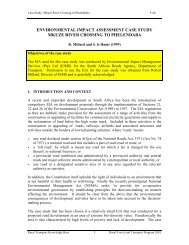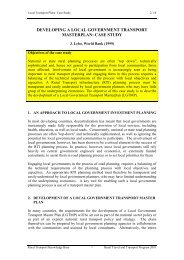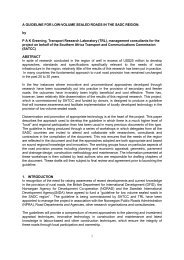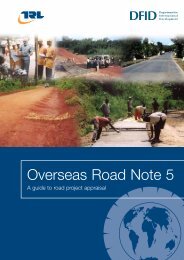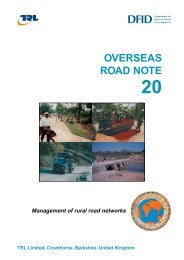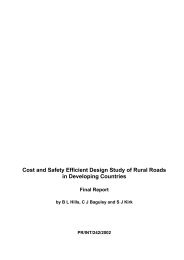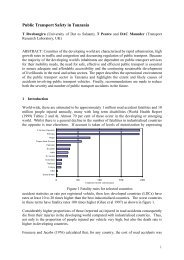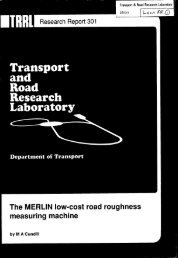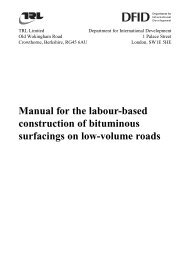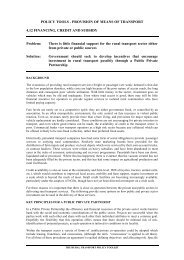LR706 East African Flood Model_ Fiddes - Transport for Development
LR706 East African Flood Model_ Fiddes - Transport for Development
LR706 East African Flood Model_ Fiddes - Transport for Development
You also want an ePaper? Increase the reach of your titles
YUMPU automatically turns print PDFs into web optimized ePapers that Google loves.
1934. The response of cascading flows through a number of linear reservoirs both in series and parallel was<br />
studied<br />
by Sugawara and Marayamas.<br />
The purpose of this study is to develop a model which can be applied to ungauged catchments using very<br />
few measurements of catchment characteristics such as area, slope, soil type. The model must there<strong>for</strong>e be<br />
simple and have a limited number of parameters. The lumping or averaging of certain catchment mechanisms<br />
inherent in a simple reservoir model is thus not a disadvantage. ~ls was there<strong>for</strong>e considered to be the most<br />
suitable type of model <strong>for</strong> the <strong>East</strong> Africa study.<br />
3. THE TRRL FLOOD MODEL<br />
3.1 Description of model<br />
The model is made up of two parts. A linear reservoir model is used <strong>for</strong> the period between the rain<br />
hitting the ground surface and the floodflow entering the stream system (the “land phase”) and a finite<br />
difference routing technique is used <strong>for</strong> the passage of the flood wave down the river to the catchment outfall.<br />
A reservoir is said to be linear if the outflow<br />
linear relationship<br />
(q) is related to the water stored in the reservoir by the<br />
1s q=K . . . 2<br />
where<br />
S is the reservoir storage<br />
K is the reservoir lag time<br />
The flow from a linear reservoir with zero inflow decreases exponentially. The lag time maybe conveniently<br />
thought of as the time required <strong>for</strong> the recession curve to fall to approximately + of its initial value.<br />
The reservoir storage contains the rain falling during the storm which contributes to the flood hydrography.<br />
This can either be surface runoff or rapid subsurface runoff (interflow). Runoff does not occur uni<strong>for</strong>mly over<br />
a catchment. Parts of the catchment are less permeable than others due to variation in soil type, or, in low<br />
lying areas, to slower drying out after previous rain. A uni<strong>for</strong>m runoff coefficient can there<strong>for</strong>e be misleading<br />
and recently the concept of catchment contributing area (CA) has been substituted.<br />
Between storms, drying of the soil takes place due to the combined effects of evaporation and plant<br />
transpiration. The drying takes place principally in the surface layers. This accounts <strong>for</strong> the high infiltration<br />
rate at the start of a storm and also <strong>for</strong> the lack of subsurface runoff until this loss has been made good by<br />
infiltration. This is modelled by a storage called initial retention (~, which must be filled be<strong>for</strong>e flood runoff<br />
occurs.<br />
The simple land phase model may there<strong>for</strong>e be summarised as:<br />
(a) firly rain fills the initial retention (~. Runoff at this stage is zero.<br />
(b) Subsequent rain falling on the parts of the catchment from which runoff will occur (CA) enters<br />
the reservoir storage.<br />
3



